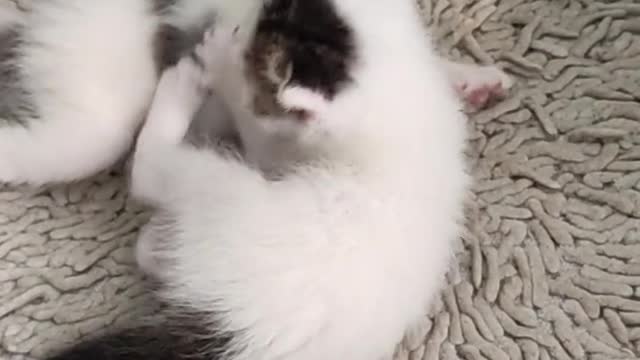Premium Only Content

two kitten playing with each other #kitten #cats
two kitten playing with each other #kitten #cats #cuteanimals #cutecats #cat #pets #cutepets
When you have a multi-cat household, it's always best when your cats get along. But sometimes figuring out when playtime between two cats has crossed the line into something more serious can be tough to determine. When your cats are chasing each other, hissing, and pouncing, you may find yourself wondering, "Are my cats playing or fighting?" To answer the question, observe how they hold their ears and tails and how they act around each other outside of playtime.
Watch Their Body Language
Body language can tell you a lot. Both playing and fighting can involve jumping on each other, chasing, and even a little hissing. It's not unusual for play fighting to appear a bit aggressive. Your cats might also "play bite" without causing injury.1 Cats that are play fighting tend to take turns, letting one cat be at the bottom of the wrestling huddle and then the other. They might even take brief breaks to rest. If your cats' bodies are relaxed or their ears are pointed forward, they're likely just playing.2
If your cats flatten their ears, hold their ears back, or puff up their fur or tails, this is a sign that they're fighting, not playing. Defensive, puffy postures and leaning away from each other while hissing with bared teeth are signs that your cats feel threatened and aren't having fun. Chasing a tired cat until it hides could also be a bad sign. Inflicting injury is another indication things have gone too far.
How Do They Act When They're Not Playing?
Watching how your cats act around each other when they're not playing can help you see more clearly how serious the situation is. If they groom each other, cuddle with each other, or generally live peacefully together, they're likely just playing.
However, some cats may feel bullied or tense around each other because they're fighting, not playing. In those situations, they may avoid each other, or even hiss or growl when the other is near. They may freak out a little if they accidentally touch each other. You might also see signs of insecurity in one or both cats. These signs can include hiding, pooping outside the litter box, spraying in inappropriate places outside the box, or becoming extra destructive and even lashing out at you.
How You Can Help Them Get Along
If you think your cats are fighting, don't despair—you're not powerless. First, try to redirect your cats' attention with a feather wand when things start to get tense between them. (Just remember, do not step in between fighting cats or try to grab one and pull it away from the other.)
Plug in Comfort Zone Multi-Cat Diffusers throughout your house in the rooms where your cats like to hang out. These diffusers emit odorless, drug-free vapors that mimic a cat's pheromones. They signal to your cat that everything is safe, secure, and calm. When there's tension between two cats, these diffusers can help induce a more calming, happy atmosphere. You can also use the BreakAway Comfort Zone Calming Collar on every cat in the house to provide comforting vapors 24/7.
Cats that don't have enough activities may take out their nervous energy on each other. Set up window perches, condos, and cat trees in multiple rooms to give them more spaces to claim as their own territory. Give them interactive toys and engage them in lots of playtime. You can also try clicker training to give them a mental workout.3 If you have a cat harness and leash, you could even take them on walks in your backyard.
Reintroducing Your Cats
If you find you can't redirect their attention at all and these other activities aren't helping, you may need to reintroduce your cats as if they're meeting for the first time. This involves keeping them in separate rooms, swapping scents, and feeding them on opposite sides of a closed door. Once they're calm when sensing the other, feed them on opposite sides of a screen or gate. Then graduate to limited, supervised visits. Over time, they'll learn the other isn't a threat.
It can be tough to know where the line is between playing and fighting. If you see signs of fighting between your cats, some extra supervision and playtime can help. Remember: it's always okay to talk to a cat behaviorist or your veterinarian if you're not sure what to do next. With the right steps, most cats can learn to be friends again.
-
 2:05:15
2:05:15
Steven Crowder
5 hours agoTrump's Ukraine Mineral Deal Explained: How this Could Effectively End the War
391K200 -
 1:24:58
1:24:58
Simply Bitcoin
3 hours ago $1.38 earnedCONFIRMED: Wall Street Giants FIGHTING Over The Last 1.2M Bitcoin! | EP 1235
21.7K1 -
 LIVE
LIVE
ROSE UNPLUGGED
22 hours agoThe Colorful Lie: Dr Malone on Why Food Dyes Are Under Fire
92 watching -
 LIVE
LIVE
The Dana Show with Dana Loesch
2 hours agoKAMALA HARRIS: RETURN OF THE CACKLE | The Dana Show LIVE on Rumble! THURSDAY MAY 5TH 2025
486 watching -
 1:04:19
1:04:19
Timcast
3 hours agoUS Elites Built UNDERGROUND Bunkers Preparing For DOOMSDAY Scenario
101K87 -
 1:24:41
1:24:41
Rebel News
2 hours ago $1.67 earnedGoogle pays Cdn media, Ford rips 'broken' bail system, Liz May wants to be Speaker | Rebel Roundup
24.2K5 -
 LIVE
LIVE
IrishBreakdown
3 hours agoNotre Dame Getting More Freshman Reinforcements - IB Top 25 Rankings
158 watching -
 1:58:26
1:58:26
The Charlie Kirk Show
2 hours agoStephen Miller Wrecks the Press + Replacing Mitch McConnell | Morris, Peterson, Bessent | 5.1.25
59.4K16 -
 1:10:28
1:10:28
The Rubin Report
4 hours agoDave Rubin & Ro Khanna Debate: Trump's 1st 100 Days & Are Judges Above the Law?
52.4K98 -

Flyover Conservatives
13 hours agoLive Q&A - Dementia, Alzheimers, Memory Loss and Brain Health - Dr. Bryan Ardis | FOC Show
37.8K2